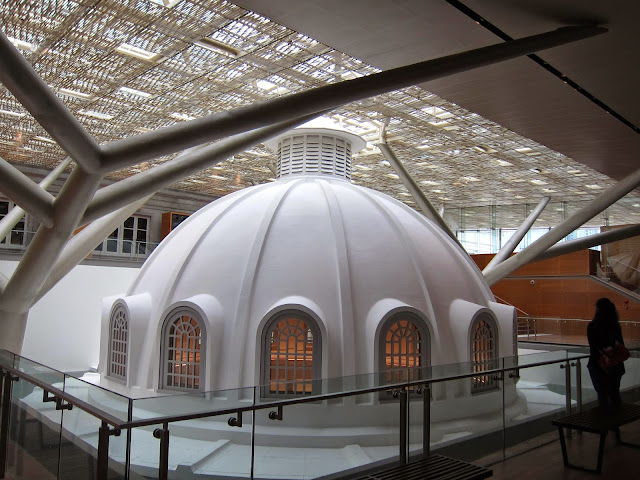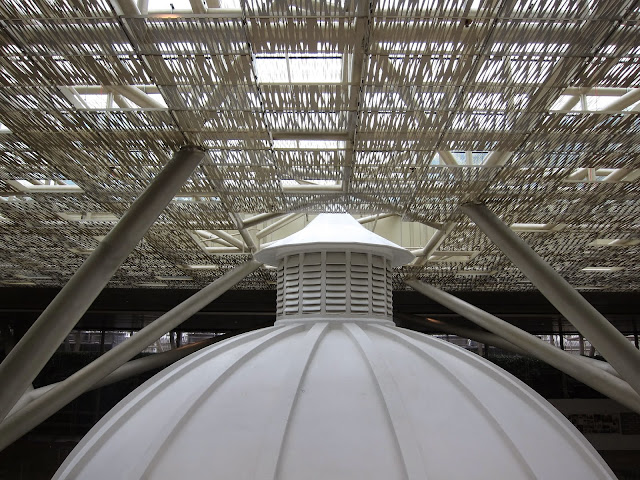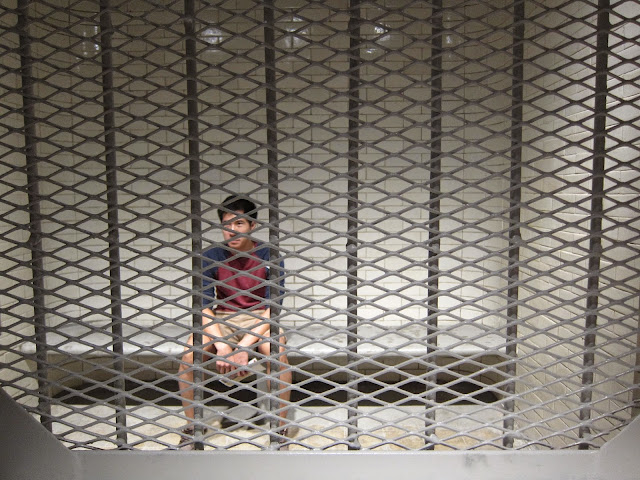Hi guys!
Last Saturday (02 May 2015), I was invited by The A List to have an exclusive "Naked Museum" tour of the National Gallery Singapore (新加坡国家美术馆), before it is officially opened to the public in November 2015 and I must that it was truly a memorable experience!
* since there are no art exhibits in the museum, it is named the Naked Museum
What is the National Gallery Singapore about?
The National Gallery Singapore will focus on showcasing Southeast Asian and Singapore Art, dating back to the 19th century to the present day. Through the extensive collection of art works, the Gallery will be able to illustrate and present to visitors the development of Singapore and its neighbors' cultures, which depicts their social, economic and political histories as well.
The National Gallery mainly focuses on Modern Art but it will take a contemporary approach and look beyond national and regional boundaries of art, and take on a wider ambit of international visual arts culture, research into the Asian heritage and cultural affiliations while also engaging with global cultures and discourses.
The National Gallery mainly focuses on Modern Art but it will take a contemporary approach and look beyond national and regional boundaries of art, and take on a wider ambit of international visual arts culture, research into the Asian heritage and cultural affiliations while also engaging with global cultures and discourses.
Credit: National Gallery Singapore
Logo of the National Gallery Singapore
 Photo credit: Marketing Interactive
Photo credit: Marketing Interactive
I know it looks really simple and some may think that it is a "no brain-er" kind of design which probably anyone on the streets can come up with but it does reflect on the architecture of the National Gallery Singapore, as seen below:
Photo credit: Everything Also Complain
The Asylum (Singapore), the design firm behind the logo took 3 months to come up with the concept. The firm took a bold approach towards the creation of the logo through an abstract representation of the two iconic buildings housing the National Gallery Singapore, the logo comprises two rectangular blocks and it can be interpreted in any imaginable way — two building blocks, two dialogue boxes, two platforms or just two spaces for visual arts.
The two basic geometric shapes pays homage towards the movement of abstraction in the early 20th century, of which the Bauhaus movement was a prominent example. This is also evident within the development of modern art, which is the focus of the National Gallery.
The logo has received mixed reviews and some netizens got really creative and came up with their own interpretations of the logo to simply poke fun at the simple logo.
The two basic geometric shapes pays homage towards the movement of abstraction in the early 20th century, of which the Bauhaus movement was a prominent example. This is also evident within the development of modern art, which is the focus of the National Gallery.
The logo has received mixed reviews and some netizens got really creative and came up with their own interpretations of the logo to simply poke fun at the simple logo.
Who says that Singaporeans are not creative?
Identity of National Gallery Singapore
The National Gallery Singapore is about art and it aims to excite, engage and inspire all their visitors.
The color palette used is a mixture of charcoal grey or red, both being timeless colors that represents strength and steadfastness, inline with the Gallery's vision of becoming a visual arts institution that will inspire and engage Singaporeans, people from the region and linking everyone around the world through art.
The font used is Akzidenz-Grotesk, a modern yet simple and versatile font which will blend in well alongside the Gallery's exhibits, making it inviting, dynamic, inspiring and confident.
Credit: National Gallery Singapore
Construction of the National Gallery Singapore
The former Supreme Court and City Hall were closed in 2005 for extensive renovation, paving the way for the birth of National Gallery Singapore - the nation’s newest museum. Construction of the museum is being executed by studio Milou Architecture, a Paris-based firm which specializes in museum design and the adaptive re-use of historical and heritage buildings, and its Singapore partner, CPG Consultants - began in 2011 and is now approaching its final stages.
To create a more inclusive environment, the museum will have multimedia guides that will be available in the four official languages and daily tours led by gallery docents, said Mr Lawrence Wong (Minister for Culture, Community and Youth & Second Minister for Ministry of Communications and Information).
A special history exhibition, highlighting key historical moments that took place at the former Supreme Court, is also slated to be held next year.
Credit: Channel News Asia
The Singapore Courtyard
10 Fun Facts about the National Gallery Singapore
1. The total cost for the project is estimated to be $530 million.
2. The combined floor area of the National Gallery Singapore will be around 64,000 sq m, comparable in size to the Musee D’Orsay in Paris and the Museo Nacional Del Prado in Madrid.
3. The sculptures on the former Supreme Court’s friezes and tympanum were designed and sculpted in the 1930s by Italian Cavalieri Rudolfo Nolli.
4. There are more than 10,000 artworks in Singapore's National Collection and the new museum will display about 1,000 of them at a time.
5. The National Gallery Singapore will house the largest collection of South-east Asian art in the world.
6. 15,000 aluminium panels, all in shades of gold, will make up the National Gallery Singapore’s roof and veil, a sloping extension of the roof which runs down the museum’s main entrance between the two buildings.
7. The former Surrender Chamber on the third floor of City Hall weights approximately 2000 tons and had to be suspended using a series of steel beams during construction.
8. The museum will house the Keppel Centre for Art Education, the first dedicated art education facility of its kind in Singapore and the region. It will occupy over 1,000 sq m of the ground level in the City Hall wing.
9. The ponds in the rooftop gardens serve double duty as skylights. Made of steel frames and laminated glass, they allow natural light to flow into the courtyards below.
10. In the 80 years since the construction of the former City Hall, the building’s shallow foundations caused the building to twist as it settled. Now the north-west corner of the building is 1m taller than its south-west corner, and the floors of the building are slanted.
Credit: Straits Times

The clean and simple feel is being exemplified throughout the whole National Gallery, even the staircase are wide and simple.
I am so glad that by opening my mouth to ask a stranger to snap a photo for me, I got acquainted with another photography lover.
A look inside the Rotunda Library! There used to be such a huge collection of books that the space is insufficient to store them.
This used to be the holding cell for inmates waiting for their cases to be heard at the Old Supreme Court. There were a total of 12 inmate cells; 10 for men and 2 for women and they were located just below the court rooms. Today, at the new National Gallery, 2 of the 12 cells still remains.

The architecture of the interior is simple and clean, with usage of white walls with wooden fixtures and floor. The roof has been fitted with glass panels with a reflective pool above, which provides natural lighting. This is a good move to reduce energy consumption of the National Gallery Singapore. Look! We have a surprise guest coming to visit the National Gallery as well! Do not be alarmed as the two buildings were previously home to many of our feathered friends such as pigeons and swallows and some of them still call this place their home.
Once you go up to the rooftop, you will be greeted by a spectacular view, featuring the glass reflective pool and the new Supreme Court is in the background with its distinctive UFO-like structure.
The dome of the Former Supreme Court as seen from the rooftop
The skyline of Singapore's CBD, with the Victoria Theatre and Concert Hall in the foreground being towered by the skyscrapers at the back, such as One Raffles Place and UOB Plaza One.
This reminds me of tree branches or like the same structure that is supporting the glass roof of ION Orchard. Look at how tiny these people are as compared to the structure of the building.
Looks like someone's home! Let's not disturb!
The symbolic white-font "Naked Museum" block
How can I miss out on a photo opportunity for keep sake?
The Grand Old Rotunda Library is being restored and looks very photo-worthy!
How about a more artsy shot?
The clean and simple feel is being exemplified throughout the whole National Gallery, even the staircase are wide and simple.
Let's have a game of chess on the floor!
Waffle anyone?
Let's head to the outdoor patio for some fresh air!
This is probably the next most Instagrammable staircase in Singapore! Photographers and Instagrammers time to get ready your cameras and mobile phones this coming November!
A look inside the Rotunda Library! There used to be such a huge collection of books that the space is insufficient to store them.
The buildings
The Former Supreme Court and the City Hall are national monuments and have played a significiant role in Singapore's history. Facing the Padang (Flat Field in Malay), the two buildings are now being integrated together via link bridges and a new basement level, combining both old and new architecture.
Former Supreme Court
The Former Supreme Court building was built on the site of the former Grand Hotel de l'Europe, one of the most palatial hotels in Southeast Asia that was demolished in 1936. Designed by Frank Dorrington Ward, Chief Architect of the Public Works Department, the former Supreme Court building was built to house Supreme Court offices and courtrooms and was declared open on 3 August 1939.
This building is the former courthouse of the Supreme Court of Singapore, before it moved out and commenced operations in the new building on 20 June 2005.
The architecture of the former Supreme Court building is in harmony with that of its neighbour, City Hall. The general layout of the building exemplifies British colonial architecture, comprising four blocks of offices and courtrooms surrounding a central rotunda with a dome that was originally used to house a circular law library. It was to be the last classical building to be built in Singapore. United Engineers Ltd was the building contractor.
City Hall
The City Hall building was built between 1926 and 1929 and was originally known as the Municipal Building. Designed by the British Municipal architects A. Gordon and S. D. Meadows, it was used to house the offices of the Municipal Council, which was responsible for the provision of water, electricity, gas, roads, bridges and street lighting.
From 1963 to 1991, City Hall came to house offices of several government departments and courtrooms. City Hall has been the focal point of many important events in the history of Singapore. It was in the City Hall building that Admiral Lord Louis Mountbatten, on behalf of the Allied forces, accepted the surrender of the Japanese forces on 12 September 1945.
The building also housed the office of Mr. Lee Kuan Yew, the first prime minister of Singapore. Mr. Lee and members of his Cabinet took their Oaths of Allegiance and Oaths of Office on 5 June 1959 in the City Hall Chamber.
It was gazetted on 14 February 1992 as a national monument. The original layout of City Hall is a typical example of neoclassical British architecture. The building's interior is modestly proportioned, but its front façade is distinguished by 18 three-storey-high Corinthian columns facing the Padang.
From 1963 to 1991, City Hall came to house offices of several government departments and courtrooms. City Hall has been the focal point of many important events in the history of Singapore. It was in the City Hall building that Admiral Lord Louis Mountbatten, on behalf of the Allied forces, accepted the surrender of the Japanese forces on 12 September 1945.
The building also housed the office of Mr. Lee Kuan Yew, the first prime minister of Singapore. Mr. Lee and members of his Cabinet took their Oaths of Allegiance and Oaths of Office on 5 June 1959 in the City Hall Chamber.
It was gazetted on 14 February 1992 as a national monument. The original layout of City Hall is a typical example of neoclassical British architecture. The building's interior is modestly proportioned, but its front façade is distinguished by 18 three-storey-high Corinthian columns facing the Padang.
Credit: Wikipedia
Mark your calenders and watch out for this space as it is super photogenic and Instagrammable!
Thank you The A List for the invite!
Mark your calenders and watch out for this space as it is super photogenic and Instagrammable!
Thank you The A List for the invite!
National Gallery Singapore
1 St. Andrew's Road
Singapore, 178957
Nearest MRT Station: City Hall (North-South Line/ East-West Line)
Further readings:




















































ReplyDelete